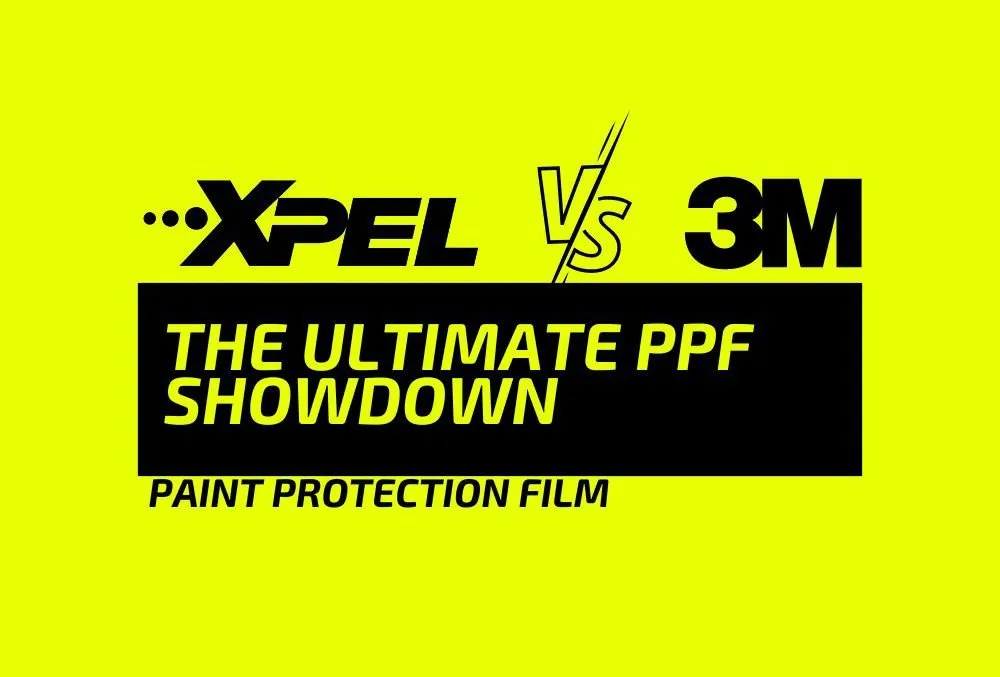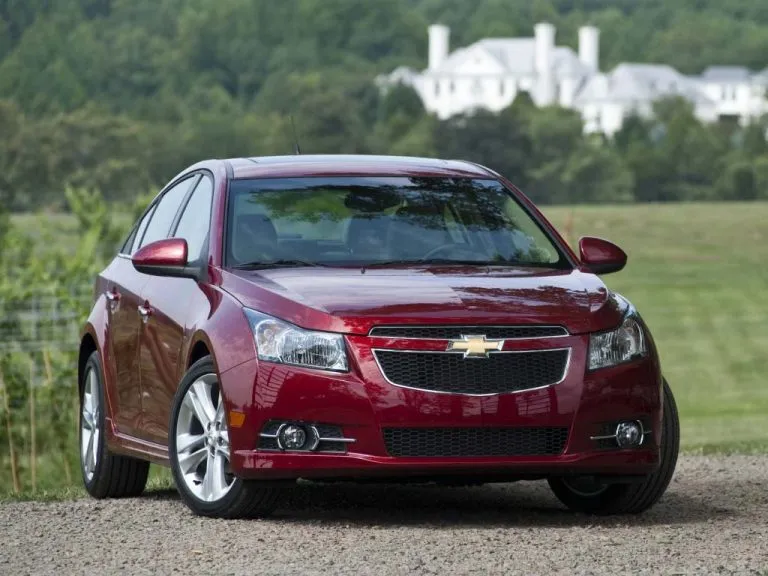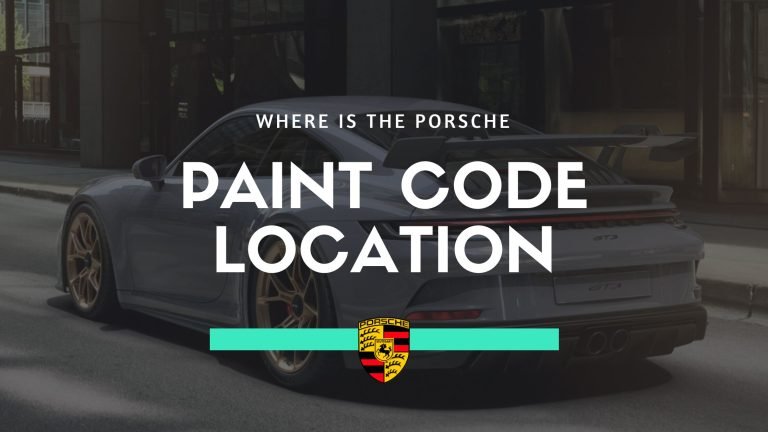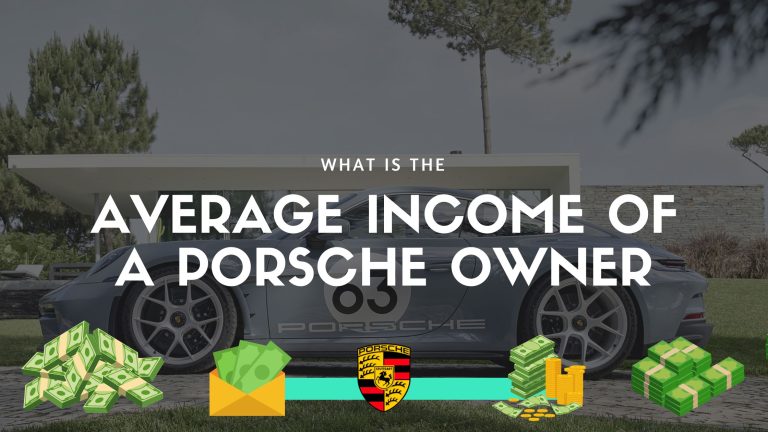Xpel vs 3M Paint Protection Film: The Ultimate PPF Showdown
Protecting your vehicle’s paint job is a top priority for anyone that loves cars, choosing the right car paint protection film can make all the difference. Two popular options in the market are XPEL and 3M, each with their unique properties and benefits.
XPEL paint protection film is known for its self-healing properties and durability. Compared to 3M films, it is more resistant to yellowing and fading. Additionally, XPEL offers thicker options, ranging from 6.60 mils to 9.6 mils (23 mils for their Armor but that’s a non-transparent film so we’re not counting it), which provides extra protection against severe impacts. On the other hand, 3M paint protection film, while less expensive in the short term, tends to show signs of yellowing and wear after a few years.
Before buying, you need to consider the level of protection you desire, your budget, and the long-term value of the product. By understanding the differences between XPEL vs 3M paint protection films, you can make a decision on the best paint protection film for your car. In this article, we’ll explore the features of both XPEL vs 3M paint protection films to help you understand what’s best for you.
TLDR Summary
While looking for the best paint protection film for your car, the two leading options are XPEL and 3M. To help you understand their differences, let’s look at some key points.
XPEL is known for its self-healing properties, meaning that it can repair minor scratches on its own. Although 3M’s film also has self-healing abilities, XPEL’s capabilities are considered superior. This gives XPEL an edge when it comes to paint protection.
Thickness is another difference to consider. XPEL offers thicknesses ranging from 6.60 mils to 9.6 mils, while 3M offers thicknesses from 6 mils to 8 mils. Thicker films provide additional protection against more severe impacts, so keep in mind that XPEL films are generally thicker than 3M’s.
When it comes to warranties, XPEL provides a 10-year warranty and lifetime installation guarantee, whereas 3M offers a 10-year warranty only on their Pro Series 200 Gloss PPF, some believe that it’s only a 7-year warranty, but this only applies to 3M’s Series 100 Gloss PPF and it gets even more tricky, as when you step down to their standard Scotchgard PPF, it’s only backed by a 5-year warranty.
In terms of durability and resistance to yellowing and fading, XPEL films have a better reputation. This makes XPEL a popular option for those wanting to protect their car’s paint job for an extended period.
Now that you’re aware of these differences, you can make an informed decision on XPEL vs 3M paint protection film and which is the best choice for your car. Enjoy keeping your car’s paint in pristine condition!
Xpel Vs 3M Paint Protection Film
When it comes to car paint protection film, there’s two big players in the industry, XPEL and 3M. Both offer high-quality products, but not all car paint protection film is created equally.
XPEL films have gained a solid reputation for their durability and ability to provide top-notch protection against paint chips and light scratches. With a thickness range of 6.60 mils to 9.6 mils, these films are generally thicker than 3M films, which offer thicknesses from 6 mils to 8 mils. A thicker film can provide additional protection for your car’s paint against more severe impacts.
On the other hand, 3M has been around for ages, and the first company to file a patent for paint protection films. 3M films are used by many new car manufacturers worldwide, as well as NASCAR. Although the thickness of their films is generally a bit less than XPEL, 3M films still offer solid protection for your car’s paint.
When comparing transparency, XPEL is known for producing a more transparent film than 3M, which can make it look more natural on your car’s paint. However, some people have found that 3M’s protective film does a better job protecting car paint, depending on the specific application and personal preferences.
Now, regarding warranty, 3M Scotchgard Pro Series 200 offers a 10-year warranty then a 7-year warranty and 5-year warranty for their lower grade products, while XPEL Ultimate and LLumar Platinum/SunTek Ultra (other players in the PPF market) offer a 10-year warranty. Keep in mind that warranties will only remain valid if you take good care of the film and maintain it properly.
XPEL and 3M are both great options for car paint protection film. There’s heaps of important factors to look at such as thickness, transparency, durability and warranty before you commit to the right paint protection film for your car.
Fundamentals of Paint Protection Films
History and Development
In the beginning, paint protection film (PPF) was designed to protect vehicles’ paint from harsh conditions and debris. PPF found its roots during the Vietnam War, as the U.S. Military needed a solution to protect helicopter rotor blades from damage. The M Corporation, now known as 3M, developed the first protective films that later evolved into the automotive PPF industry leader.
Over time, numerous companies joined the PPF market to offer competing solutions. Today, two of the most popular brands in the industry are 3M and XPEL. Both of these brands have developed a variety of different products with differing thicknesses and other key benefits to suit different needs, giving you an opportunity to choose the best protection for your car’s paint.
3M – Industry Pioneer
3M, the first company to patent paint protection film, has earned an exceptional reputation in the industry. Many new car manufacturers and NASCAR teams trust 3M protective films for their vehicles, well at-least as the official window film of NASCAR, I’m not 100% sure if they use 3M PPF on the rest of the car. 3M offers various thicknesses, ranging from 6 mils to 8 mils, each designed to provide robust protection for your car’s paint.
XPEL – Protective Innovator
XPEL, another prominent PPF brand, is known for its thicker and more resilient films. With options ranging from 6.60 mils to 9.6 mils, XPEL protective films can provide extra protection for your vehicle against more severe impacts. They are well-regarded for their durability in defending against paint chips and light scratches.
When choosing between 3M or XPEL, keep in mind that product warranties vary. While 3M’s Scotchgard Pro offers a 10-year warranty that drops as you go down the 3M PPF range from 10 to 7 to 5 years, XPEL Ultimate and even some alternative brands such as LLumar Platinum and SunTek Ultra boast a 10-year warranty, giving you an assurance of long-lasting performance.
Types of Paint Protection Films
XPEL
XPEL offers a range of paint protection films (PPF) to suit your needs, two popular options are XPEL Ultimate and XPEL Stealth. The XPEL Ultimate is an optically clear PPF that provides great protection against rock chips, scratches, and other hazards. It comes in thicknesses ranging from 6.60 mils to 9.6 mils to give you the level of protection that suits your needs.
Now, let’s say you have a matte or satin finish paint job on your car. The XPEL Stealth is designed for you. It offers similar protection as the XPEL Ultimate but with a unique satin finish, to preserve the aesthetics of your car’s paint. Both films come with a 10-year warranty, indicating confidence in their performance and longevity.
3M
3M has been in the paint protection game since they filed the first patent for it. Since the beginning of PPF, they’ve been offering a solid range of PPF products, such as 3M Scotchgard Pro and 3M Paint Protection Film.
3M Scotchgard Pro Series is a high-quality PPF that is warrantied for 10 years, which means you can trust its longevity. It comes in various thicknesses between 6 mils to 8 mils, allowing you to choose the right level of protection for your car.
Both XPEL and 3M PPF products excel at protecting your car’s paint from potential damage. Depending on your preferences or the specifics of your vehicle, you may find one option more suitable over the other.
Key Features and Differences
Self-Healing Properties
When it comes to self-healing properties, XPEL paint protection film (PPF) has a clear advantage. XPEL was the first PPF to feature this unique ability, and their self-healing technology is still considered top-notch. If your car gets minor scratches, you’ll find that they disappear with time thanks to XPEL’s self-healing properties.
On the other hand, 3M PPF also has self-healing properties but does not quite stack up to XPEL in terms of performance.
Stain Resistance
Both XPEL and 3M PPF offer excellent stain resistance, ensuring your car’s paint stays looking fresh and clean. The XPEL Clear Bra product provides superior protection against dents, scratches, and other contaminants compared to 3M’s offerings. 3M PPF might cost less in the short term, but investing in XPEL is worth it for the long-term protection.
UV Protection
A key difference between XPEL and 3M PPF is their ability to resist UV damage. Old 3M paint installation films are known to yellow and crack under UV exposure after a few years or even a year, as I’ve seen on a few of my friends cars, which is noticeably more obvious on white cars. On the other hand, XPEL PPF effectively guards your car’s paint against the harmful effects of UV rays while maintaining its pristine appearance.
Finish and Aesthetics
In terms of finish and aesthetics, both XPEL and 3M offer similar product lines. However, XPEL’s compound is more resilient, which contributes to its ability to provide better protection against paint chips and light scratches. Additionally, XPEL PPF is known for its hydrophobic properties, which make water bead and roll off the surface of the film, keeping your car cleaner for longer.
3M’s Scotchgard Pro Paint Protection Film offers a high-quality finish as well, with weather, scratch, and stain resistance. It features a self-healing film to help minor scratches disappear. A matte version of the film is also available, which can enhance the unique aesthetics of your car.
Performance and Durability
When it comes to performance, both XPEL and 3M stand out as the best paint protection films on the market. They’re known to offer an extraordinary level of protection against road debris, rock chips, and paint chips. Trusting either of these films would go a long way in safeguarding your car’s paint job for a long time without any hiccups.
XPEL offers a thicker film compared to 3M (only slightly), with thicknesses ranging from 6.60 mils to 9.6 mils, while 3M’s thicknesses range from 6 mils to 8 mils. This additional thickness in XPEL’s film can provide extra protection against more severe impacts, ensuring your paint remains pristine for a longer period.
On the durability front, XPEL’s self-healing properties are some of the best in the industry. When exposed to direct heat from a heat-gun or sunlight, any minor scratches on the film will simply disappear, leaving your car looking good as new. This is not to say that 3M doesn’t have this feature, the self-healing properties are there, but many people have said it’s just not as effective as XPEL. Plus, XPEL’s film is resistant to yellowing and fading, so you won’t have to worry about the material losing its luster.
When it comes to warranties, XPEL offers a 10-year warranty on its Ultimate product, while 3M’s Scotchgard Pro series film comes with a 10-year warranty, which then drops along with the lower grade PPF products they offer as mentioned above. Although the warranty periods differ, you can trust that both companies offer a well-performing product when paired with a quality installation.
Either path you go down, you can’t go wrong with XPEL or 3M paint protection film. Your car will be well-protected from road debris, rock chips, and paint chips, ensuring it remains in top-notch condition. Just remember that a professional, quality installation the key tying all of this together, without it, you can have the best quality PPF in the world and it would perform poorly.
Maintenance and Care
When it comes to maintaining your car’s appearance, both XPEL and 3M paint protection films (PPF) require proper care. Let’s dive into some key aspects of maintenance and care for these popular PPF options.
Ceramic coating can be an excellent addition to your PPF, providing extra protection to your car’s paint. You can apply a ceramic coating on top of the XPEL or 3M film, which will create a smooth, hydrophobic surface. This enhances the appearance of your car and also makes cleaning easier, allowing dirt and debris to slide off the surface effortlessly.
Bird droppings are a common nuisance for car owners, potentially damaging your car’s paint and leaving behind unsightly stains. Both XPEL and 3M PPF can save your car’s paint from the acidic nature of bird droppings. However, cleaning them as quickly as possible is still recommended. Gentle car washing techniques, like using a soft sponge and pH-balanced soap, will help maintain the PPF’s quality and your car’s appearance.
Chemical stains might also cause harm to your car’s paint, but luckily, both XPEL and 3M PPF provide protection against these types of damage. For example, these films can protect against harsh chemicals found in popular cleaning products, road salt, and even gasoline spills. Regardless of this protection, it’s probably a good idea to still wipe away anything off the paint.
Regular maintenance is required for both XPEL and 3M PPF, including washing. It’s essential to follow the guidelines when using cleaning products or techniques, as some may damage the films. Also, remember to avoid abrasive materials, such as hard brushes or harsh cleaning chemicals, to prevent damaging or compromising the PPF’s protective qualities. Keep in mind, that there’s plenty of products out there designed to help maintain your PPF, one product I’ve used a lot in the past is a product by Gyeon called Q2M PPF Maintain, it’s super simple to apply and has made the PPF shine like it’s new.
Taking care of your car’s PPF is not only necessary but also straightforward. By performing routine maintenance, using gentle cleaning practices, and acting quickly when faced with bird droppings or chemical spills, you can keep your XPEL or 3M PPF in top shape, preserving your car’s appearance and the longevity of the film for years to come.
Additional Considerations
Choice Between XPEL and 3M
When choosing between XPEL vs 3M paint protection films, there are a few factors to consider. Both options provide quality films designed to protect your vehicle’s paint from damage caused by debris and environmental factors. XPEL is generally thicker and has better self-healing properties, meaning minor scratches or swirls disappear over time as the polymer structure rebounds. On the other hand, 3M offers a strong, durable film backed with their reputation as the first patent holder for paint protection film.
Ultimately, the entire decision between XPEL and 3M comes down to personal preference. You might prioritize better self-healing features or perhaps lean towards a long-standing, reputable brand like 3M.
Vehicle Value and Resale
Protecting your car’s glossy paint and overall appearance is important for maintaining its resale value. Buyers tend to be more interested in vehicles with well-preserved paint, which can have a significant impact on resale price. I was recently selling a high end car and all of the potential buyers wanted to know what PPF was on the car and if I put the PPF on the car from when it was brand new, not surprisingly, every single person was happy to hear that it was installed before I hit the road in my car when I first bought it. Using quality paint protection films like XPEL or 3M can help guard against the type of damage that lowers a vehicle’s worth. Remember, the goal is to keep your car looking new for as long as possible; investing in a high-quality film can help achieve that.
Alternatives to XPEL and 3M
Though XPEL and 3M are popular options, there are other automotive paint protection films on the market you may want to consider as well. SunTek Ultra is a solid alternative that also comes with a 10-year warranty, similar to XPEL Ultimate.
When considering alternatives, take into account the self-healing feature, relatively low-maintenance, and the overall quality of the film. The ideal solution will protect your car’s paint and help maintain its value over time. Take your time choosing the right best paint protection film and make sure you check out the spec sheets when comparing.
Conclusion
When considering paint protection film for your car, there’s really only two big players in the game: XPEL and 3M. Both offer their unique qualities to keep your vehicle’s paint looking fresh and well-protected. Let’s break down the key differences in a simple way.
XPEL:
- Known for its self-healing properties
- More durable and long-lasting
- Resistant to yellowing and fading
3M:
- The first paint protection film brand
- Trusted by car manufacturers globally
- Chosen by NASCAR for their vehicles
In terms of thickness, XPEL and 3M differ, which can impact their durability. Keep in mind that both brands offer warranties to back up their product and prove to you that it’s a quality PPF. 3M’s Scotchgard Pro comes with a 10-year warranty, but keep in mind the lower grade PPF 3M options only offer a 7 or 5 year warranty, while XPEL’s Ultimate offers a 10-year warranty.
To make the best decision for your car, first figure out your specific needs what you want to get out of a paint protection film. Both XPEL and 3M have proven themselves in the industry with their commitment to quality and performance, so either choice will be a step toward preserving your vehicle’s appearance for years to come. Hopefully everything we’ve mentioned guides you down the right path for you and you can enjoy your car with the peace of mind knowing the paint will always be perfect.




